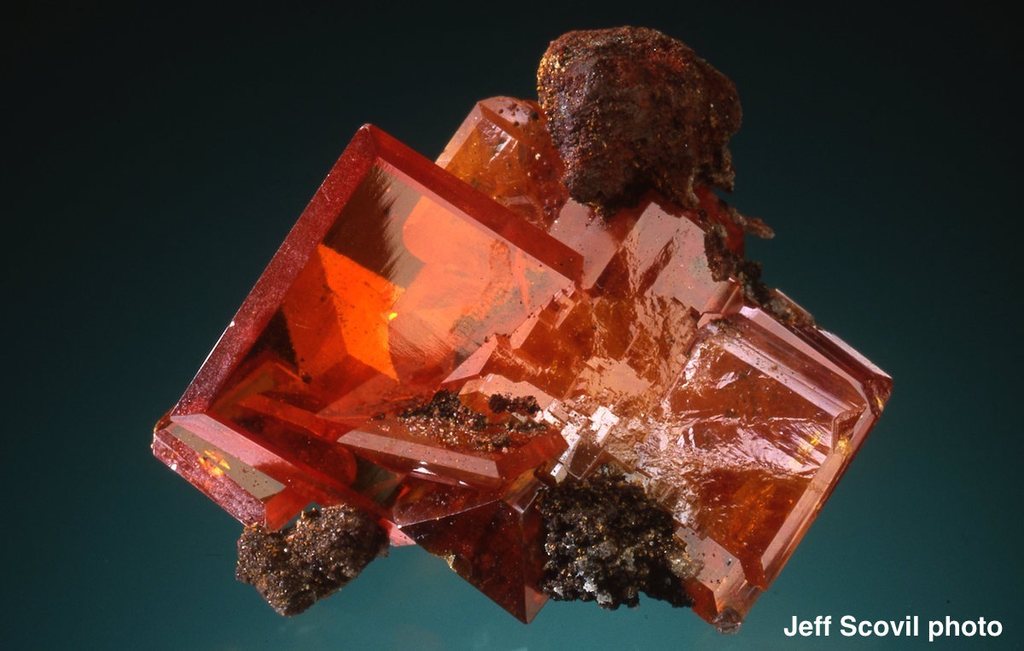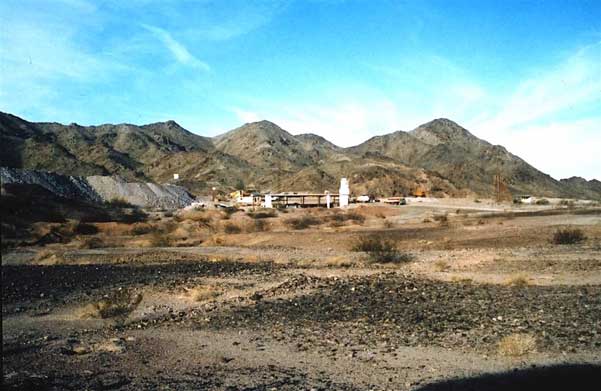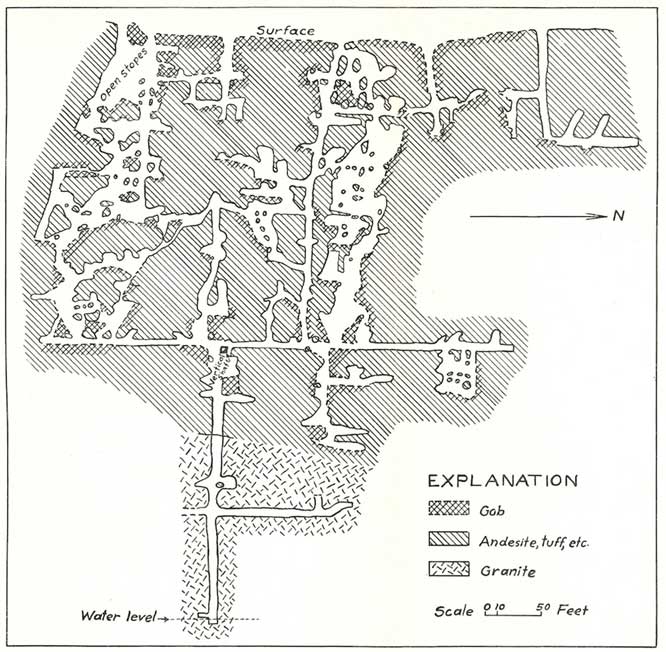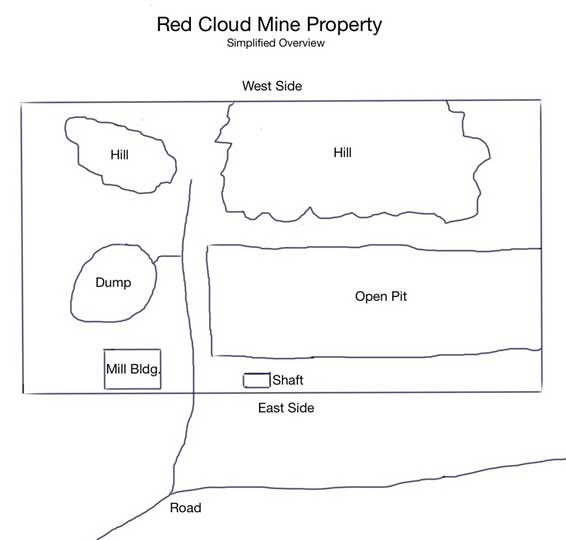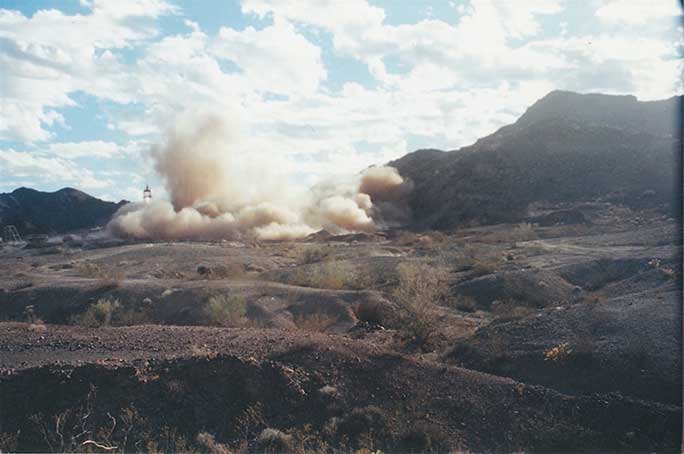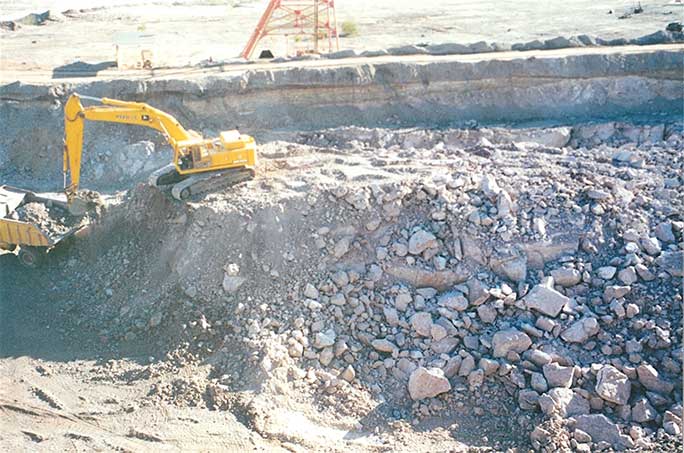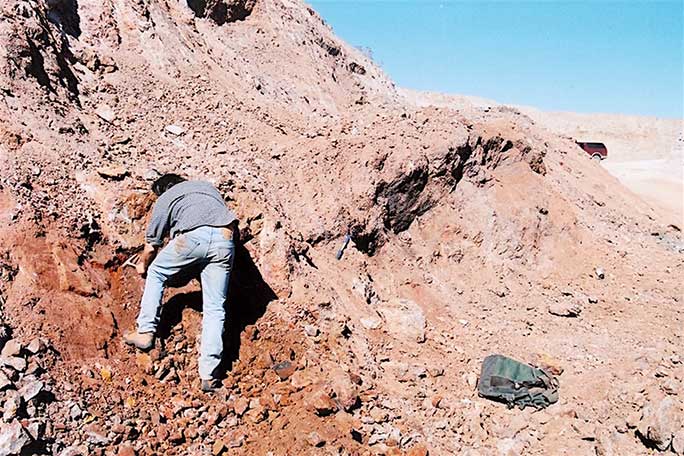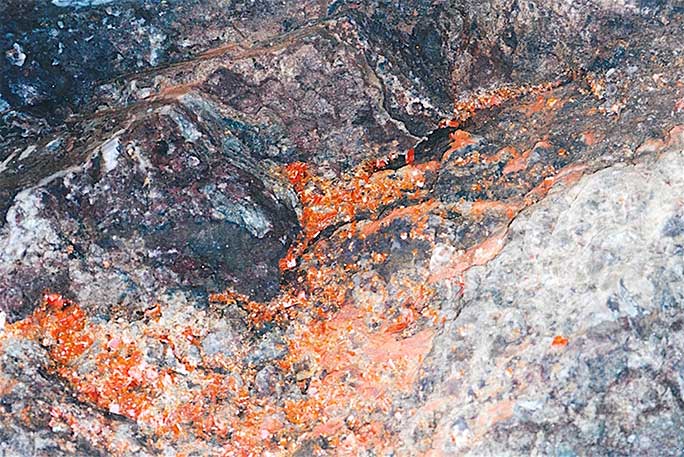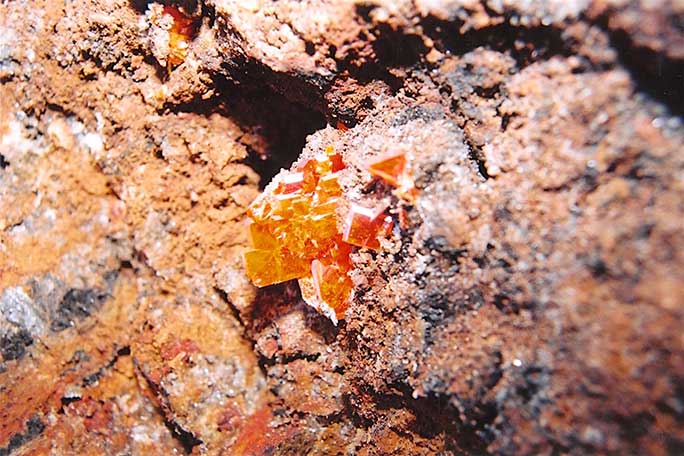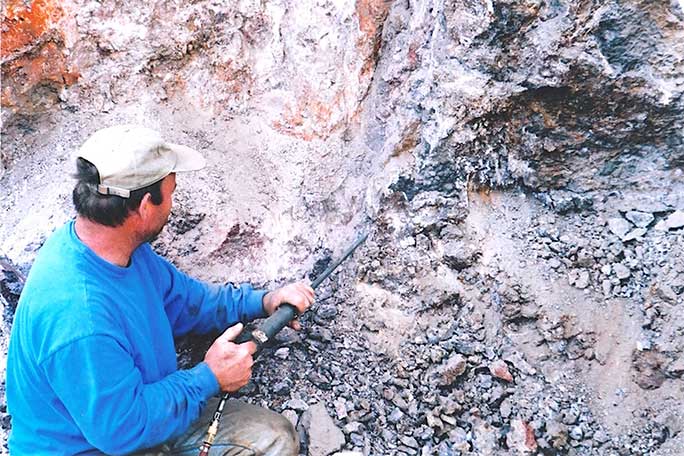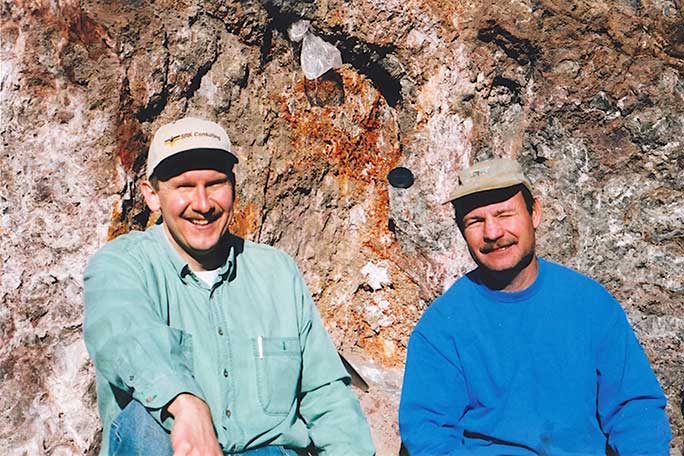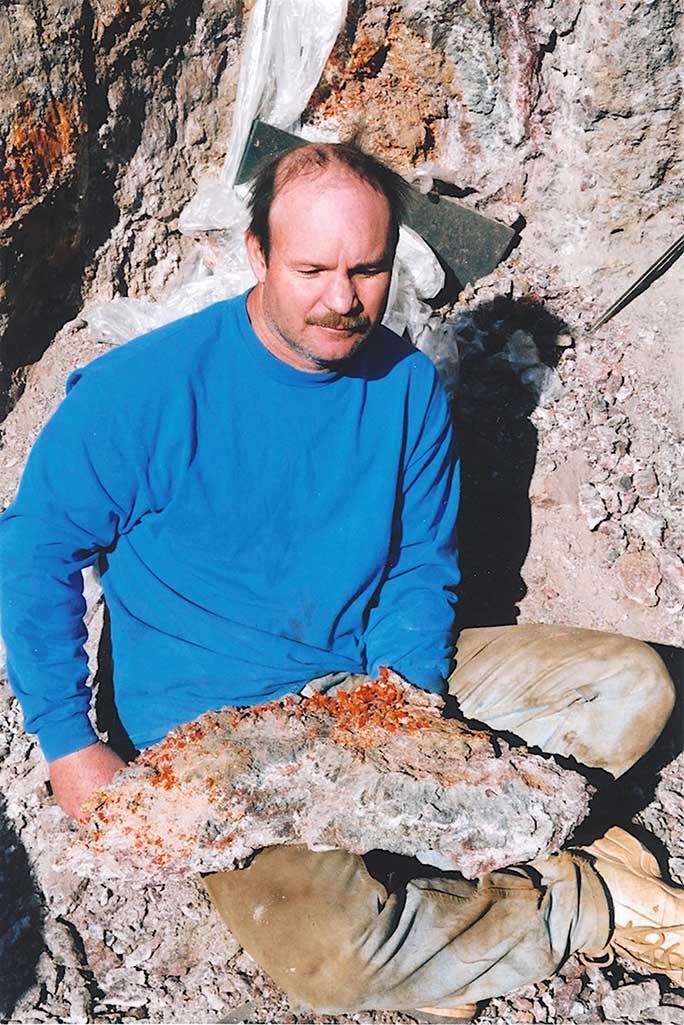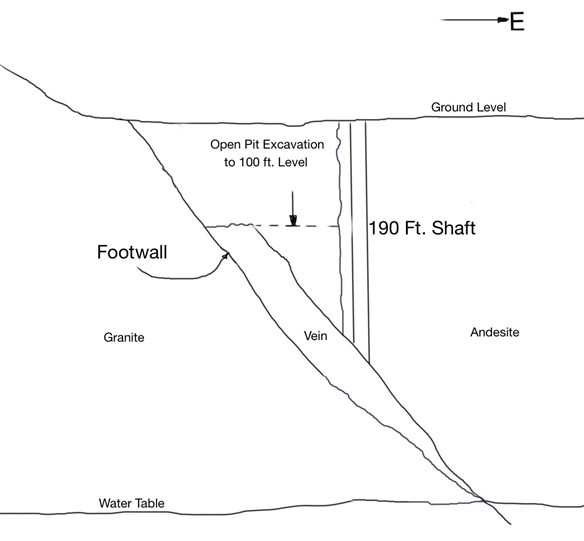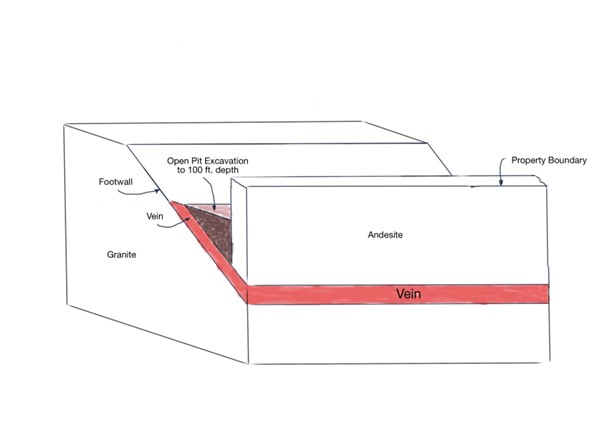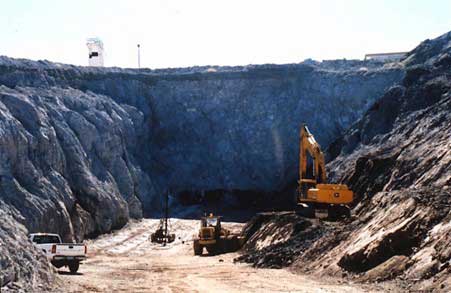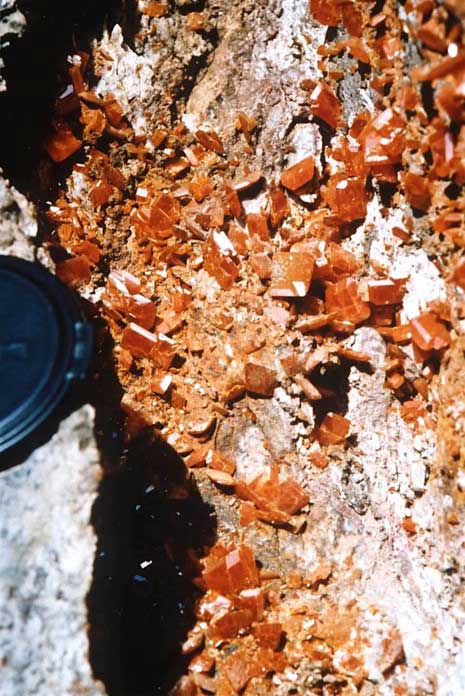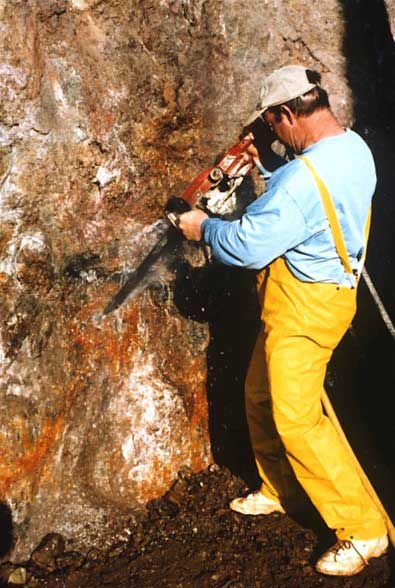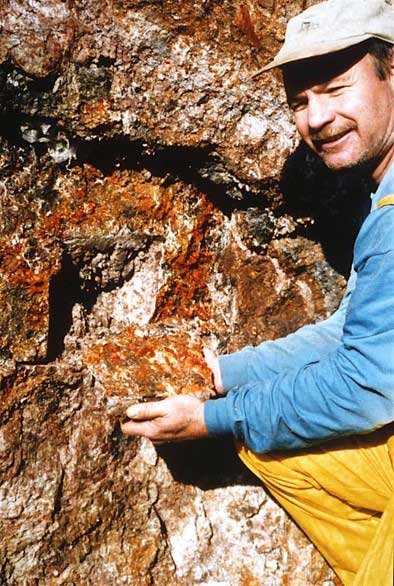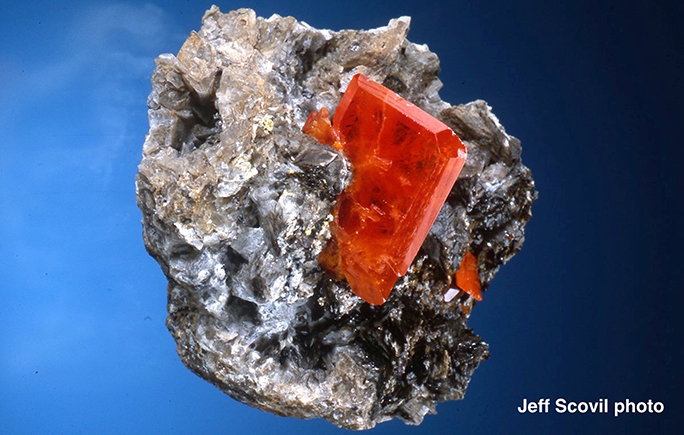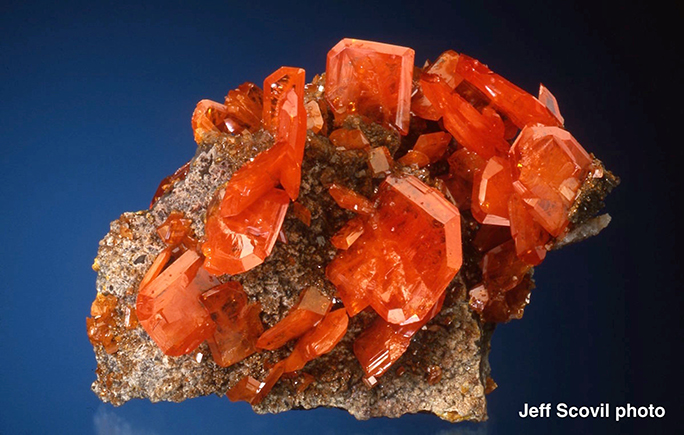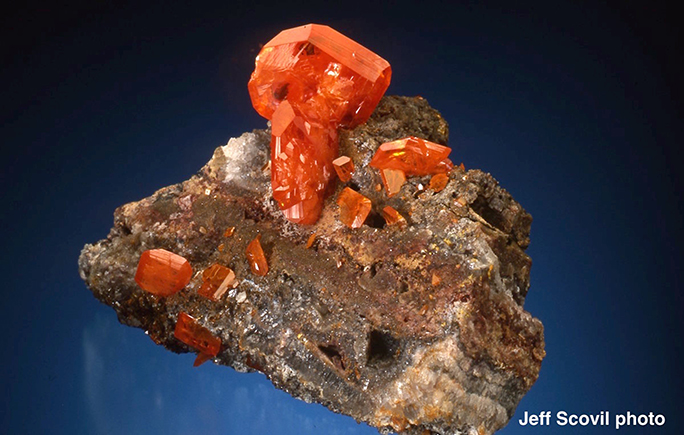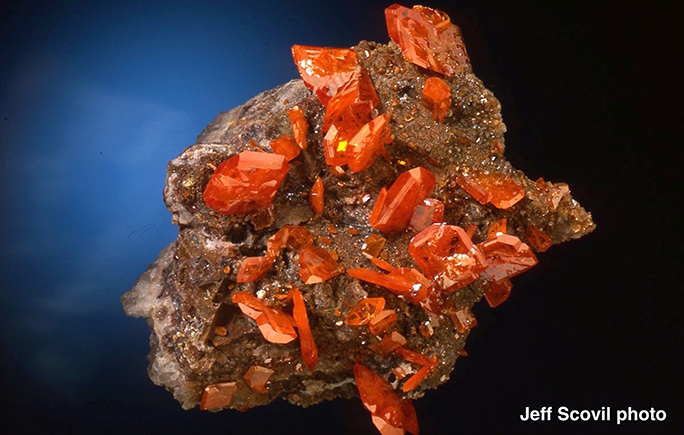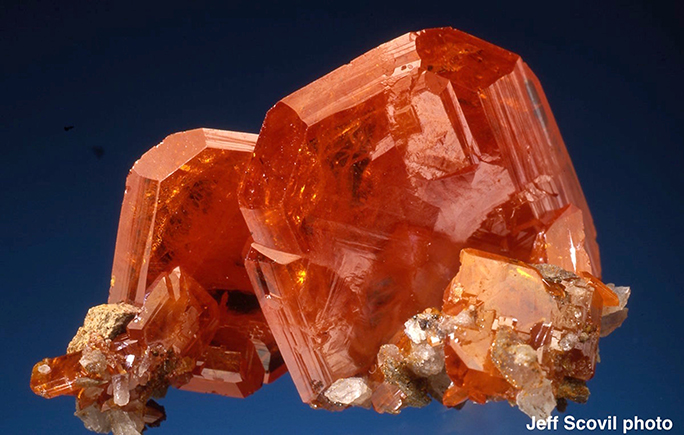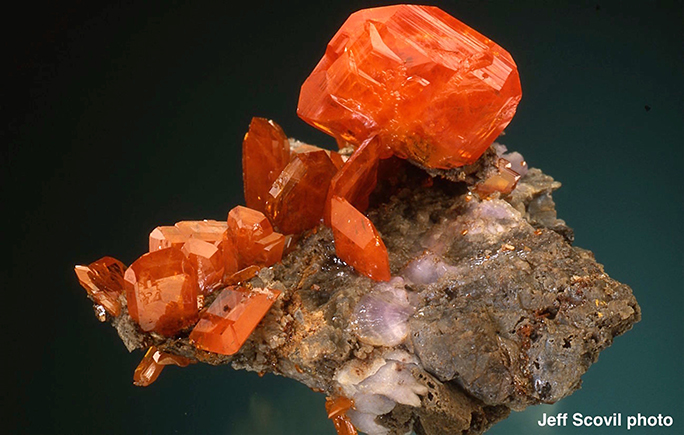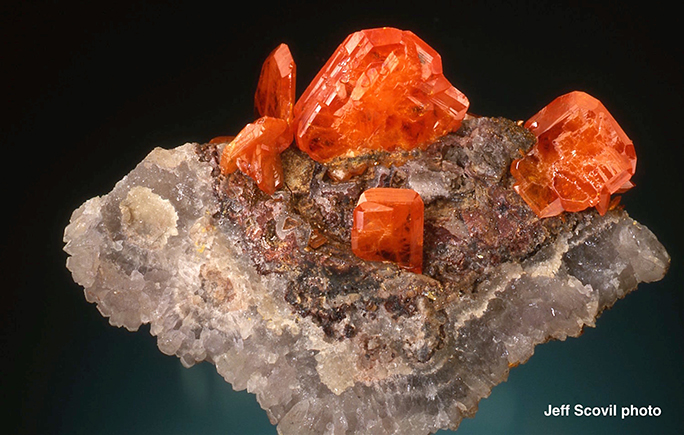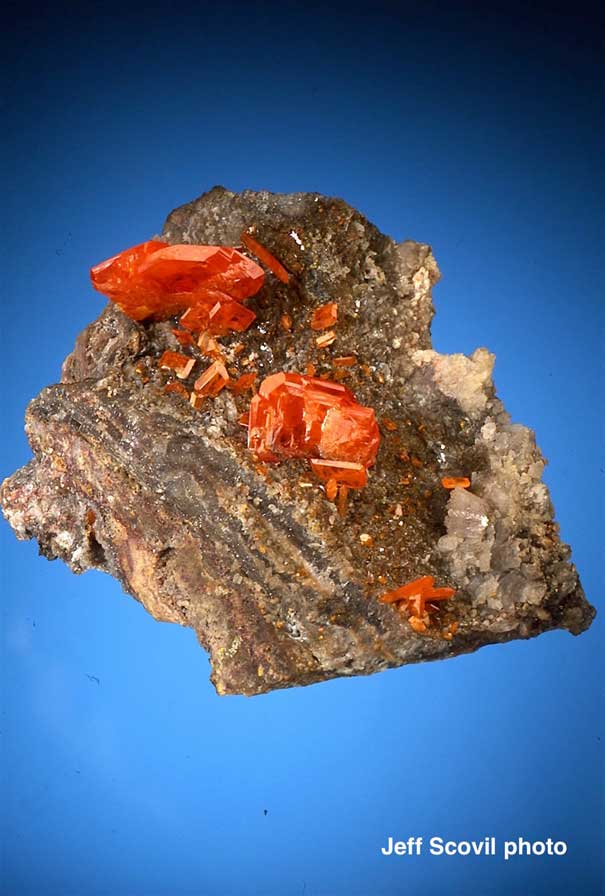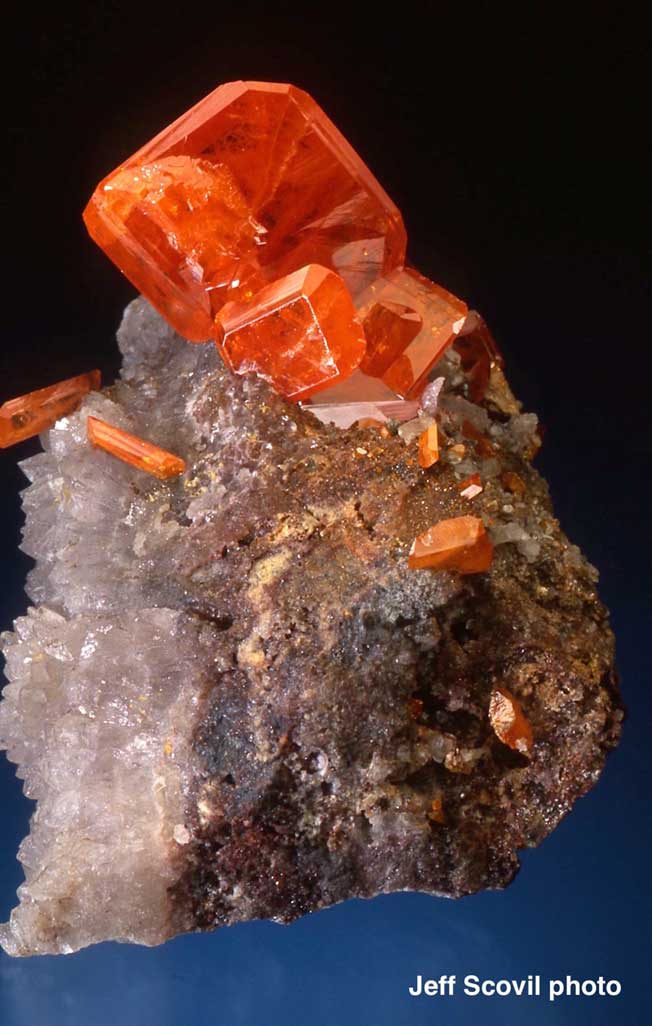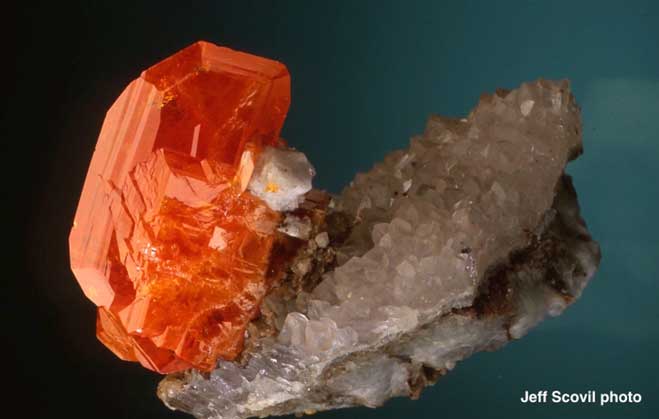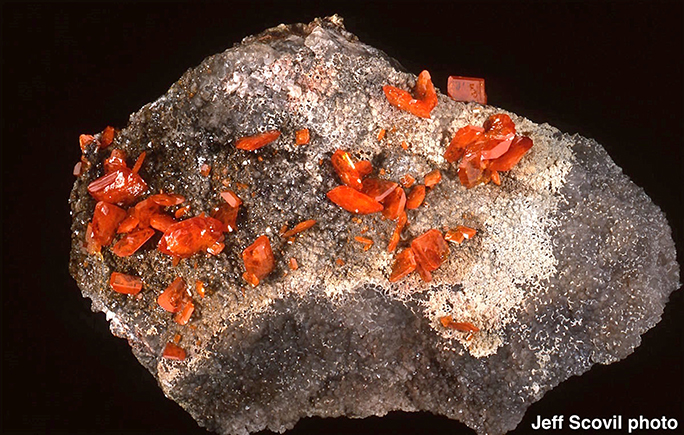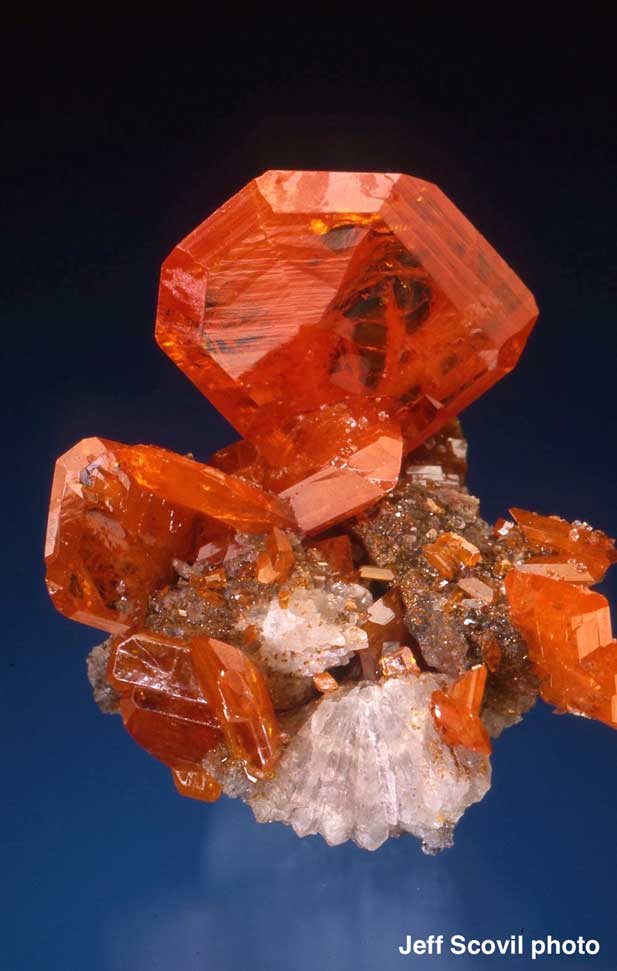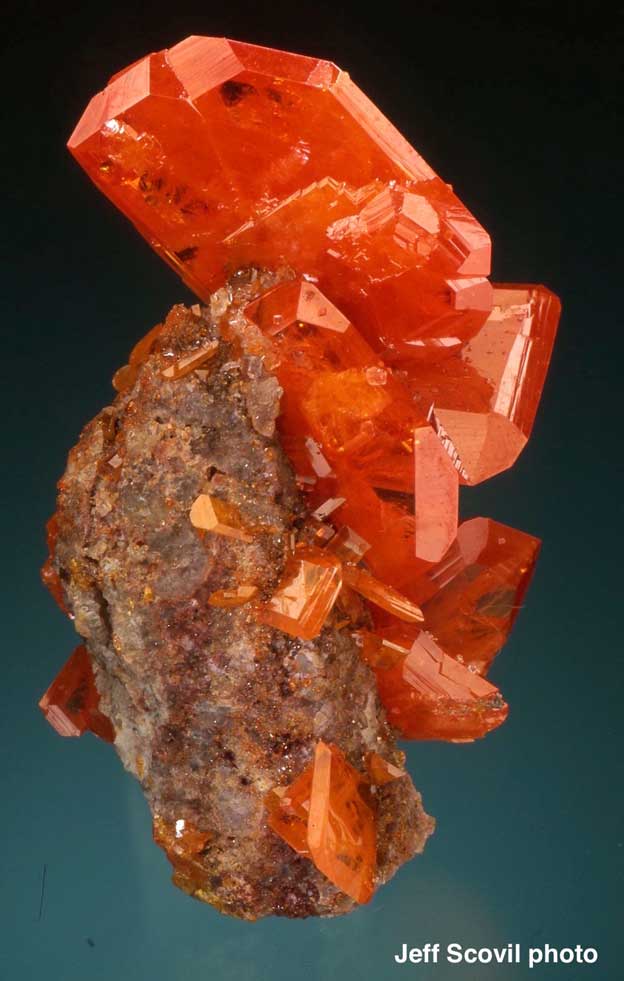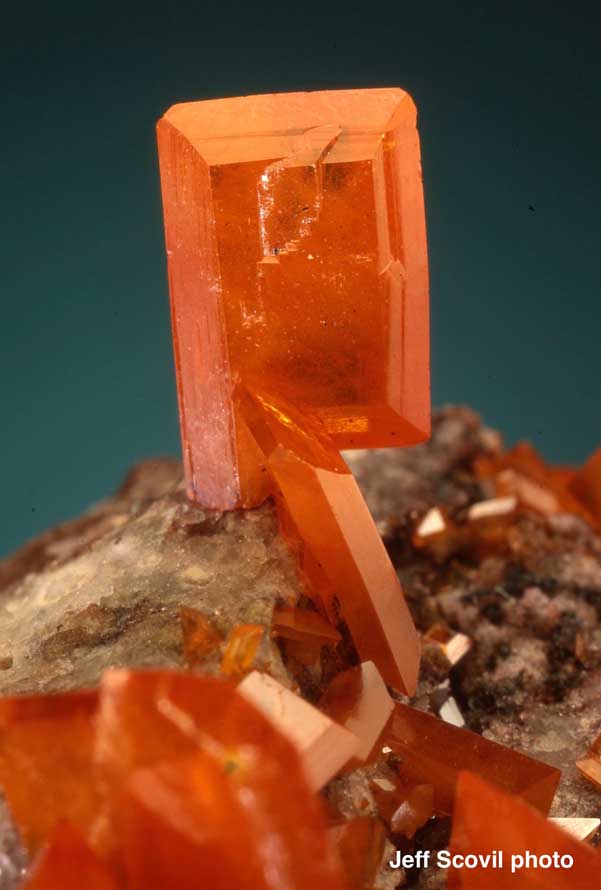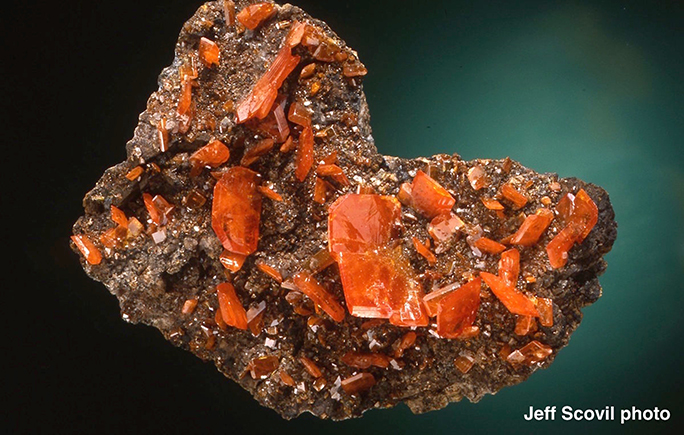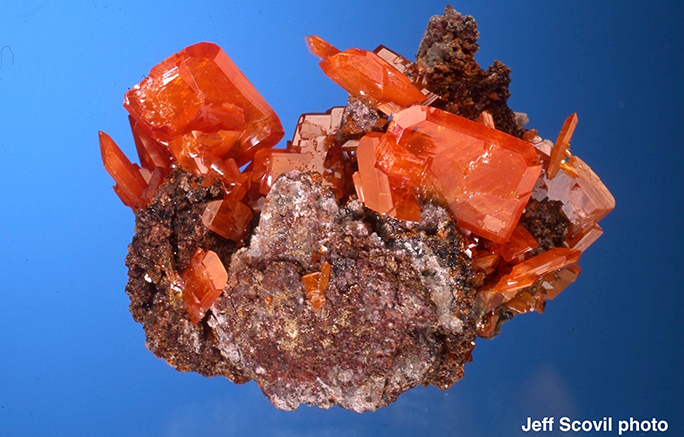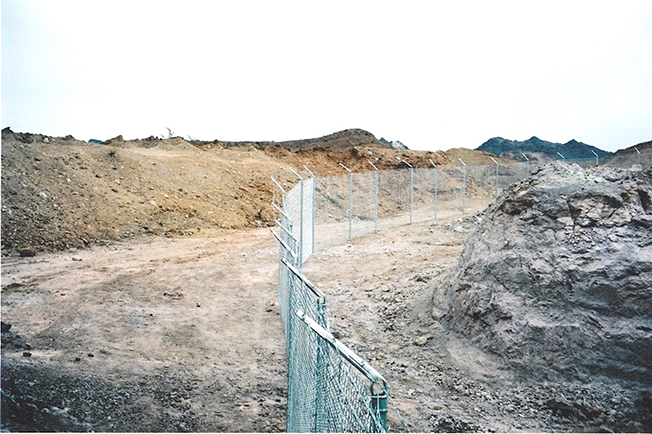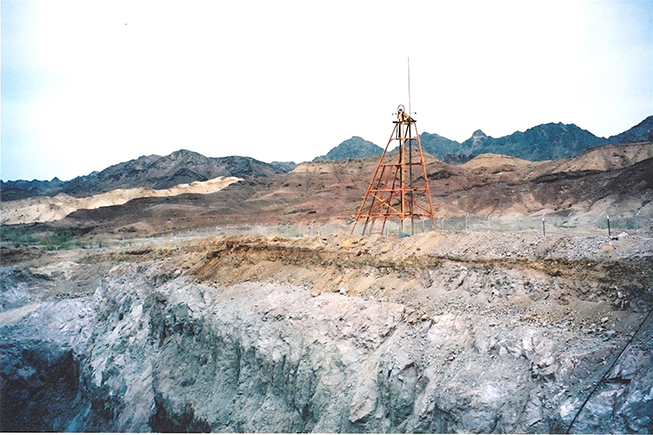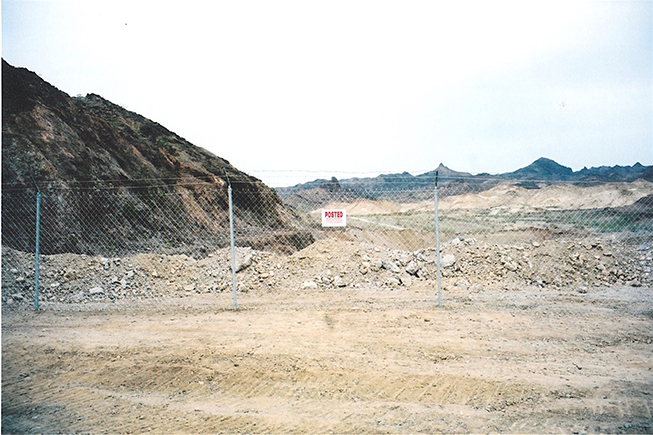Introduction
In 2001 Colorado Calumet Co, Inc. (CCCI), acquired the Red Cloud mine from Wayne Thompson et.al. The mine is a small silver-lead deposit located in the arid and desolate southwest corner of Arizona, and CCCI worked the claim for two years. The spectacular bright orange-red wulfenites from this mine that have been produced here since 1880 are world famous and most collectors would agree that crystals from this occurrence provide the finest examples of the species ever found. Red Cloud is considered as one of the premier wulfenite localities in the world with fine pieces gracing many private collections and museums. Unfortunately, the supply of crystals has never been sufficient to meet the demand, although commercial specimen mining efforts have sporadically provided inventories that offer collectors brief windows of opportunity to purchase handsome specimens.
Location
The Red Cloud mine is located in what is called “The Silver District” in the Trigo Mountains, La Paz County, Arizona about 212 miles southwest of Phoenix, Arizona and 51 miles north of Yuma, Arizona. It is about 15 miles north of Martinez Lake, the nearest town, and is accessed by a sandy and gravelly tortuous road passing through a barren landscape of rugged hills and dry washes. Everything alive in this part of the Arizona desert either bites, stings, or has stickers. Working outdoors in the summertime is generally impossible; even in the dead of winter, daytime temperatures commonly exceed 80 degrees Fahrenheit. Water is especially precious, and must be pumped from deep wells, even at the mine site.
History
The vein deposit exploited by the Red Cloud mine was originally discovered in 1878 by a prospector named Warren Hammond, and was worked extensively from the period 1881 through 1889. Silver and lead, averaging 10 oz/ton of silver and 6% lead, were the chief elements produced, and production totaled about $250,000 in metals prices of the period. The deposit is comprised of a northerly trending vein that dips at about 45 degrees (to the east). Preliminary mining involved open pit mining of the exposed surface ore. As the surface ore was depleted, an incline was sunk, following the vein for almost 84 meters. The mine workings were developed predominantly from underground levels and extended off from both an older inclined shaft, and a more recently, a 200 foot deep vertical shaft. The old timers created a maze of interconnected passages and small stopes in their search for pods of high-grade ore.
In 1885 the mine was patented and operations continued until 1899, producing silver, lead, and some gold, when it finally closed down. By the end of 1890 the mine workings reached the point where they are today. Though minor promotional mining schemes after 1889 were attempted over the following 114 years to continue production, no new significant ore bodies were ever found.
In 1917 the Red Cloud Consolidated Mines Company purchased the mine; however, little was done in the way of mining. The mine ended up in the hands of the Neal Mining Company in 1928.
It wasn’t until 1949 when the dumps were reworked to recover any valuable minerals still there, recovering an estimated $1 million of silver, at which point the mine was then abandoned. Since it’s inception the mine has passed through multiple hands.
Although wulfenite specimens originating from the Red Cloud were known from the first period of mining, 1880 to 1889, it was not until the historic discovery by the “legendary” Ed Over in 1938 that the notoriety of the locality leaped to fame. Working alone underground with only the most basic tools and daily necessities, this man produced some of the most beautiful wulfenite mineral specimens ever seen. An account of his experiences is detailed in The Mineralogical Record, 1975, p.176-179, and makes for fascinating and memorable reading. Today, pieces from the Ed Over find are rarely offered and command very high prices due to their important historical significance.
After Over’s discovery, collectors became fully aware of the exceptional specimen potential of the Red Cloud mine and large numbers of people began to visit the locality in search of pieces similar to those of Ed Over’s discoveries.
Through the years, local pockets were hit by those few lucky individuals who were willing to endure the miserable traveling and working conditions present at the locality. The patented claim was purchased at auction by several individuals in 1995 and in January of 1996, an actual open-pit mining operation was undertaken solely for wulfenite specimens. Luck was with this consortium and an important crystal-lined fracture was soon encountered. Specimens from this pocket were quickly consumed by the mineral market, but the operation was shortly thereafter discontinued.
Fortunately for collectors, Colorado Calumet Co, Inc (CCCI), leased the property in 2000 and began to enlarge the open pit begun in 1996 and continue the search for additional wulfenites. Because of the 45 degree dip of the mineralized structure, it was necessary to remove a much larger volume of waste rock in order to deepen the excavation and expose fresh portions of the unmined vein. An entire season was required to accomplish this mammoth project, in the process creating a huge waste rock dump (dubbed “Mount Sutton”) located on the south side of the patented claim. Two more seasons were then available for the methodical and exciting mining of fresh vein sections in search of wulfenite pockets. And, as fortune would have it, several magnificent crystal-lined fractures and pockets were again encountered. One of these pockets, dubbed the “Red Gem Pocket”, found very near the end of the operation, contained incredibly gemmy, brilliant, and deep orange-red wulfenite crystals to more than one inch in size perched upright upon loose fragments of brecciated quartz and fluorite matrix. These pieces may be the finest examples to have ever been found at the Red Cloud, and their recovery may curiously coincide with the final chapter of collecting at this truly classic world mineral locality. Shortly after this wonderful discovery, the pit design limit of 105 feet was reached and in 2003, due to economic and physical limits, the operation was permanently shut down. With this closing, CCCI went through the necessary stages of reclamation and the property was sold.
View of the Red Cloud mine, circa 2002.
Geology
In the vicinity of the Red Cloud mine, Tertiary tuffs and lavas floor a flat-bottomed valley that is bordered by ridges of lava, tuff, and sodic granite. The northwestward-trending channel of Red Cloud Wash dissects this area, and, approximately 1 mile farther downstream, cuts southwestward through the ridges toward the Colorado River. The Red Cloud mine is approximately 1070 feet above sea level, and the granite ridge westward rises to a maximum of some 800 feet higher. The tuffs east of the mine strike southeastward and dip 30° NE. Faults and fractures trending in several directions have extensively affected all of the formations. The most prominent faults strike north-northwest and, in places, form the contacts between granite and lavas. (Butler, G.M., 1933)
The Red Cloud vein occurs within a fault zone of somewhat irregular strike and dip, separating the volcanic rocks on the east from the granite on the west. At the mine, this zone strikes about N. 15° W. and dips from 45° to 60° E. The vein is made up chiefly of limonite, hematite, quartz, fluorite, and calcite, together with considerable amounts of gouge and brecciated wall rocks, all more or less stained by pyrolusite. The quartz forms irregular, finely crystalline, vuggy masses which, in places, are cut by veinlets of coarser-grained quartz. Generally, it is interbanded with gray to purple fluorite which ranges in texture from dense to crystals 0.3 cm in diameter. The calcite is mostly a coarsely crystalline, dark gray, manganiferous variety, but some later, white calcite also occurs. The limonite and hematite, which occupy cavities and vugs within the other gangue minerals, are locally intermingled with irregular, cellular masses and vug-linings of cerussite, smithsonite, pyrolusite, vanadinite, wulfenite, and very minor malachite. In places, nodules of argentiferous galena, partly altered to black anglesite and pale-yellowish cerussite, occur. The silver of this galena is probably present as minute inclusions of argentite. No other sulphides occur in the mine. Cerargyrite, present as small, disseminated masses and streaks within the oxidized minerals, constitutes the principal silver mineral. (Butler, G.M., 1933)
On the surface, the unmined portions of the Red Cloud vein are largely covered by dumps and hillside talus. Underground, the irregular shafts, drifts, and stopes have followed the vein for a length of some 560 feet and an inclined depth of 535 feet which is the water level. Most of the upper workings were made half a century ago, when the ore was sorted and screened underground and dragged up the incline in rawhide buckets. The stopes were supported by pillars, dry-wall fills, cottonwood timbers, and willow laggings which are still fairly intact. A more recent vertical shaft, approximately 200 feet deep, intersects the vein at a depth of 290 feet on the incline. Down to 360 feet on the incline, the vein has a granite foot-wall, an andesitic breccia and tuff hanging wall, and a thickness of 2 to 7 feet. Below that point, it has granite walls, steepens in general dip, and shows less mineralization. (Butler, G.M., 1933)
As indicated by the stopes sketched below, the vein contained two major ore shoots of which the southern one was from 36 to 108 feet long by 300 feet deep, and the northern one from 25 to 100 feet long by 410 feet deep. In the vicinity of these shoots, the vein shows more iron and manganese mineralization, and its walls are intersected by abundant transverse fractures. Wall-rock alteration along the vein consists chiefly of sericitization and chloritization. (Butler, G.M., 1933)
The ore body is comprised of brecciated andesite and it is within openings of the andesite that the wulfenite crystals are found.
Sketch of geology and principal workings of Red Cloud mine – Section on plane of vein – Base map of workings supplied by Neal Mining Company, circa 1933. From Arizona Bureau of Mines, Geological Series No. 7 Bulletin No. 134
Below is a simplified birds-eye view of the mine property, framed by the property boundary.
CCCI drilled a water well down to the 400 ft. level, intersecting the vein and the water table. The vein at this point had tapered down in width and was only about six inches wide, unmineralized, and ended in clay.
CCCI than began open pit mining, working from south to north along the vein. The andesite was removed in 25-30 ft. lifts. A well drilling company was hired to drill 7 inch blast holes. The holes were loaded with up to 15, 000 lbs. of explosives and shot in a pattern, holding back from the vein, such that the vein was not impacted by the blasting. Once the exposed 10-15 ft. wide vein was then worked out all the way into the footwall to recover any wulfenite that might have bled into it. Then another lift was shot. This mining effort continued in this fashion, moving down to the 100 ft. level and from south to north along the vein. As the open pit expanded to the north, following the vein dipping to the east, it became increasingly difficult to mine. Though the vein went down 400 ft. or more, there became a limit to the depth that could be mined. The space required to maneuver the excavator became increasingly smaller as the pit was deepened. At a depth of 100 ft., the limit was reached where the excavator had no further room to work in, due to the ‘pinch’ caused by the angle of the vein and nearing the eastern pit wall, approximately 20 ft. from the main shaft. After reaching the 100 ft. level at the south end, a ramp was created exiting the pit on the north end that was needed to remove the excavated ‘muck’. When about a third of the south end was mined, CCCI began to backfill the south end, creating a ramp adequate to move the excavator in and out of the pit as well as for foot traffic. Mining then continued at the 100 ft. level all the way to the northern property boundary, backfilling behind as they went. When CCCI completed its mining, the pit measured approximately 300 ft. long, 100 ft. wide, and 100 ft. deep on the east and north sides.
Initial work began by drilling and blasting lifts of andesite to the east of the vein. View to the east. Note hoisting drive building and main shaft tower in background
Shown below is a simplified drawing of the vein that ran north to south at a roughly 45 degree dip to the east. Attempting to excavate deeper by extending the pit all the way to the eastern boundary line or beyond (which would require BLM permitting) would have required the removal of a considerable amount of overburden and was deemed cost prohibitive.
This is further illustrated with the isometric drawing below.
Wulfenite: Pb(MoO4)
A secondary mineral in base metal ore deposits, wulfenite forms from the alteration of lead-bearing ores, chiefly galena. It is a common species worldwide in oxide zones, and was first named and described in the middle l700’s from ancient mines at Carinthia, Austria. Prominent world occurrences include the Tsumeb mine, Namibia, Los Lamentos, Mexico, and several deposits in Arizona in the southwestern United States. Of all these, the Red Cloud mine ranks number one for both the color and quality of its wulfenite crystals. At this deposit, it is believed that trace amounts of chromium may have been present as a component of the monzonite country rock comprising the footwall section of the vein. During oxidation and downward percolation of groundwater, the chromium was carried in solution, along with lead from galena and molybdenum from finely disseminated molybdenite. Precipitation of wulfenite from these components occurred, with the resulting spectacular color being caused by the chromium (CrO4 ion acting as a bright orange chromophor). The largest wulfenite crystals from the Red Cloud mine are reportedly those collected by Ed Over, in which examples to two and a half inches are extant. During the more recent mining operations, some very fine specimens were found, with single crystals over one inch, however, none approached the size of the former finds.
Wulfenite is a lead molybdate and crystallizes in the tetragonal system, often as tabular, pyramidal crystals. Color ranges from bright orange-red to yellow-orange, to brown crystals – sometimes even green or black. Those from the Red Cloud mine are known for their bright red, lustrous, shiny surfaces. Crystals are often tabular and have been know to reach over 6 cm on edge. Most are translucent, though they can be transparent.
It is important to know that in 1983, Yuma county was subdivided into Yuma and La Paz counties. The Red Cloud mine is now identified as in La Paz county. Consequently, older specimen labels may still show Yuma county.
Wulfenite with quartz, Red Gem Pocket, 6.3 cm high; primary crystal is at least 2.5 cm and partially gemmy
Other Minerals
Of course, the Red Cloud mine is famous for its magnificent wulfenite crystals, and the deposit will be remembered throughout history for its production of this important species. Surprisingly, other associated crystallized minerals at the deposit are quite uncommon, occurring generally as small or inconspicuous examples. Numerous descriptions listing species from the locality have been published, although several of the identifications remain in question. The following is a list of those minerals verified during mining operations or from well-documented personal accounts:
Barite, goethite (limonite), pyrite, boleite, hemimorphite, plattnerite, calcite, heyite, quartz, caledonite, kaolinite, vanadinite, cerussite, malachite, willemite, chrysocolla, massicot, wulfenite, fluorite, mimetite, galena, and minium.
Unconfirmed species described from various sources in the literature are also listed below:
Anglesite, hematite, stetefeldite, argentite, linarite, wickenburgite, chlorargyrite, pyrolusite, gypsum, and smithsonite
Of the relatively large number of minerals noted from the deposit, only three, wulfenite, cerussite, and vanadinite, are of collector interest and will be discussed in slightly greater detail.
Cerussite: PbCO3
Rare examples of crystallized cerussite have been found rarely at Red Cloud, typically as V-twinned clusters to no larger than one inch. The cerussites are colorless, predominantly transparent, but of only moderate luster. The species may rarely be associated directly with wulfenite, providing very attractive combination specimens.
Vanadinite: Pb5(VO4)3Cl
Microcrystalline crusts, coatings, and single crystal of bright orange-red vanadinite have been found on selected fracture surfaces and breccia fragments. Although individual crystals are not visible to the unaided eye, the species may locally provide a colorful background for bright wulfenite crystals.
Current Status
In 2003, mining was halted by CCCI. A ditch was dug around the open pit mine and a 5 ft. high berm was built with the dirt between the ditch and the open pit. Then a six ft. high chain length fence was installed between the berm and the open pit to keep anyone from inadvertently falling into the pit. The mine property was subsequently sold.
At closure, a chain link fence with dirt berm was placed around the open pit workings.
View of main mine shaft, outside the chain link fence. Open pit in foreground. View to the north-east.
View looking north of the fenced open pit area of mine.
References
Butler, G.M. (1933) Geology and Mineral Deposits of Southern Yuma County Arizona, Published by University of Arizona, Tucson, Arizona Bureau of Mines, Geological Series No. 7, Bulletin No. 134

